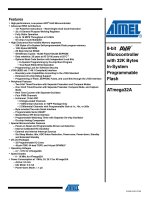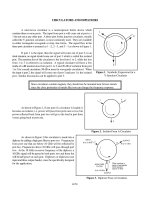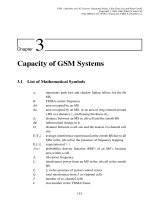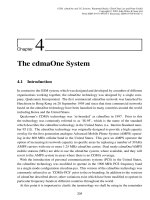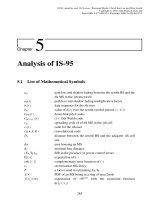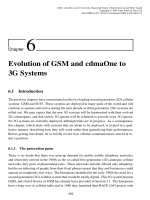Tài liệu GSM doc
Bạn đang xem bản rút gọn của tài liệu. Xem và tải ngay bản đầy đủ của tài liệu tại đây (1.8 MB, 67 trang )
04/2009
Overview
1.
INTRODUCTION TO GSM
2.
GSM ARCHITECTURE
3.
GEOGRAPHICAL NETWORK
ORGANIZATION
4.
GSM NUMBERING
5.
GSM CALLING (MOC, MTC)
Overview
1.
INTRODUCTION TO GSM
a.
What is GSM
b.
GSM services
c.
History
d.
GSM advantages and disadvantages
What is GSM?
GSM (Global System for Mobile communication)
is a Worldwide Digital Cellular Communications
Network
formerly: Groupe Spéciale Mobile (founded 1982)
used in over 184 countries
The GSM network provides for
mobile voice communication
international roaming
mobile fax
text messaging
data services
What is GSM?
GSM is a Second Generation (2G) digital radio
cellular network
Time Division Multiplexing / Multiple access
(TDM/TDMA) are employed
TDM / TDMA allows:
One frequency channel to be subdivided
Multiple conversations over a single physical
channel
GSM Subscriber Services
Two basic types:
1. Telephony (Teleservices)
Mainly voice services providing capability to
communicate with other subscribers
2. Data (Bearer services)
Capacity necessary to transmit appropriate data
signals between two access points creating an
interface to the network
GSM Subscriber Services
GSM supports the following subscriber services:
1. Dual tone multi frequency (DTMF)
tone signaling scheme used for control purposes
E.g. Remote control of an answering machine
2. Facsimile group III
GSM supports CCITT group III Facsimile
Special fax converter forms junction between
standard analogue fax and GSM FAX
GSM Subscriber Services
3. Short Message Services (SMS)
Messaging facility consisting of maximum 160
alphanumeric characters to or from a mobile
station to another
4. Cell Broadcast
Variation of SMS where maximum number of
alphanumeric characters is 93
Can be broadcast to users in a certain
geographical area.
E.g. Traffic congestion warnings
GSM Subscriber Services
5. Voice Mail
Answering machine within the network controlled by the
subscriber
Security code needed to access
6. Fax Mail
Subscriber can receive fax messages at any fax machine
7. Emergency number
common number
mandatory for all service providers
free of charge
connection with the highest priority (pre-emption of other
connections possible)
GSM Supplementary Services
GSM supports comprehensive list of supplementary
services supporting both data and voice services
The following compromises a partial list:
1. Call forwarding
2. Barring of outgoing calls
3. Advice of charge (AoC)
GSM Supplementary Services
4. Call hold
5. Call waiting
6. Multiparty service
7. Calling line identification presentation / restriction
8. Closed user groups (CUGs)
Multiple incompatible networks
Before GSM, the technical incompatibilities
between networks were due to:
operation on different radio frequencies
use of incompatible signals to control the call setup,
handoff and end of the connection.
Even when the same technological standard
existed between countries:
there were usually organisational barriers
pricing / charging schemes were incompatible
Analogue Networks
An analogue cellular system:
uses frequency modulation (FM) to send data and
signals
Divides the spectrum only into physical channels
of different frequency
Does not offer added services such as Caller ID or
Messaging
1
st
Generation Analogue
Networks
Japan1978/88NTT/NTT Hi Cap
Japan1991NTACS/JTACS
UK, Ireland, Spain1985TACS
Italy1985RTMS
France1985RadioCom
Scandinavia + 30 other countries1981/86NMT450/900
UK, 1987ETACS
Germany, Austria, Portugal, South
Africa
1981C-Netz
USA, Australia1983AMPS
How did GSM get established
CEPT formed a technical study group named
Groupe Spécial Mobile
.
The group’s mandate was to:
formulate a specification for a pan-European
mobile cellular radio system in 900MHz band
Tackle the associated technical, economic and
logistical problems.
Objectives of GSM
To provide a European “second
generation” digital network standard
Increase the market for Equipment
Manufacturers
Allow Manufacturing to establish
economy of scale.
Development Timeline
1985 – Digital Coded Speech over radio link
chosen as basis for GSM
1986 – Validation Trials held in Paris
1988 – Following successful validation
multiple invitations to tender issued
1992 – Commercial Networks Launched
First portable units
First portable units
were really big and
heavy.
Called
transportables or
“luggables”.
“Curt” – The Hotline Pocket
The first Ericsson
Handheld introduced
in 1987
Adapted from a
police radio design
firstly into a NMT-
900 compatible unit.
Later adapted for
the ETACS network.
“Olivia” - Hotline
Introduced in 1989
Originally introduced
in 1989 for the NMT-
900, ETACS and
AMPS networks
Later adapted for
GSM, and is the first
Ericsson GSM
phone.
First all digital
mobile
“Sandra”
First introduced by
Ericsson in 1991
First version used in
NMT-900 networks,
followed by version
for ETACS, D-
AMPS/AMPS
Adapted for GSM in
1993
“Jane”
Introduced by
Ericsson in 1996
Several version
manufactured for
AMPS, GSM, DCS,
PCD1900/GSM
GSM Specification
Channel coding, Interleaving, Frequency hopping, Adaptive
equalization
Diversity
Regular Pulse Excitation - Long Term Prediction (RPE-LPC)
13kbit/s
Speech coder
Time Division Multiple Access (TDMA) (narrow band)
Access Method
270 kbit/s
Transmission rate
Gaussian Minimum Shift Keying (GMSK)
Modulation
200 kHz
Carrier Separation
45MHz / 95MHz
Duplex distance
Uplink: 890 MHz – 915 MHz / 1710 MHz – 1785 MHz
Downlink: 935 MHz – 960 MHz / 1805 MHz – 1880 MHz
Frequency Band
GSM compared to 1G Systems
Communication
mobile, wireless communication; support for voice and data services
Total mobility
international access, chip-card enables use of access points of different providers
Worldwide connectivity
one number, the network handles localization
High capacity if needed
better frequency efficiency, smaller cells, more customers per cell
High transmission quality
high audio quality and reliability for wireless, uninterrupted phone calls at higher
speeds (e.g., from cars, trains)
Security functions
access control, authentication via chip-card and PIN
What are some of disadvantages
of GSM?
There is no perfect system!!
no end-to-end encryption of user data
reduced concentration while driving
electromagnetic radiation
abuse of private data possible
roaming profiles accessible
high complexity of the system
several incompatibilities within the GSM standards
